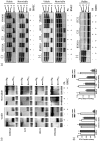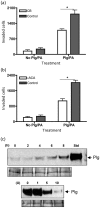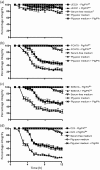Blood-brain barrier invasion by Cryptococcus neoformans is enhanced by functional interactions with plasmin
- PMID: 21998162
- PMCID: PMC3352358
- DOI: 10.1099/mic.0.051524-0
Blood-brain barrier invasion by Cryptococcus neoformans is enhanced by functional interactions with plasmin
Abstract
Cryptococcus neoformans can invade the central nervous system through diverse mechanisms. We examined a possible role for host plasma proteases in the neurotropic behaviour of this blood-borne fungal pathogen. Plasminogen is a plasma-enriched zymogen that can passively coat the surface of blood-borne pathogens and, upon conversion to the serine protease plasmin, facilitate pathogen dissemination by degrading vascular barriers. In this study, plasminogen-to-plasmin conversion on killed and viable hypoencapsulated strains of C. neoformans required the addition of plasminogen activator (PA), but this conversion occurred in the absence of supplemented PA when viable strains were cultured with brain microvascular endothelial cells (BMEC). Plasmin-coated C. neoformans showed an enhanced invasive ability in Matrigel invasion assays that was significantly augmented in the presence of BMEC. The invasive effect of plasmin required viable pathogen and correlated with rapid declines in BMEC barrier function. Plasmin-enhanced invasion was inhibited by aprotinin, carboxypeptidase B, the lysine analogue epsilon-aminocaproic acid, and by capsule development. C. neoformans caused plasminogen-independent declines in BMEC barrier function that were associated with pathogen-induced host damage; however, such declines were significantly delayed and less extensive than those observed with plasmin-coated pathogen. BMEC adhesion and damage by hypoencapsulated C. neoformans were diminished by capsule induction but unaltered by plasminogen and/or PA. We conclude that hypoencapsulated C. neoformans can invade BMEC by a plasmin-dependent mechanism, in vitro, and that small, or minimal, surface capsule expression during the blood-borne phase of cryptococcosis may promote virulence by means of plasmin(ogen) acquisition.
Figures






Similar articles
-
Invasion of the central nervous system by Cryptococcus neoformans requires a secreted fungal metalloprotease.mBio. 2014 Jun 3;5(3):e01101-14. doi: 10.1128/mBio.01101-14. mBio. 2014. PMID: 24895304 Free PMC article.
-
Induction of brain microvascular endothelial cell urokinase expression by Cryptococcus neoformans facilitates blood-brain barrier invasion.PLoS One. 2012;7(11):e49402. doi: 10.1371/journal.pone.0049402. Epub 2012 Nov 8. PLoS One. 2012. PMID: 23145170 Free PMC article.
-
Group B Streptococcus hijacks the host plasminogen system to promote brain endothelial cell invasion.PLoS One. 2013 May 2;8(5):e63244. doi: 10.1371/journal.pone.0063244. Print 2013. PLoS One. 2013. PMID: 23658816 Free PMC article.
-
How Cryptococcus interacts with the blood-brain barrier.Future Microbiol. 2015;10(10):1669-82. doi: 10.2217/fmb.15.83. Epub 2015 Oct 6. Future Microbiol. 2015. PMID: 26437710 Review.
-
Basic principles of the virulence of Cryptococcus.Virulence. 2019 Dec;10(1):490-501. doi: 10.1080/21505594.2019.1614383. Virulence. 2019. PMID: 31119976 Free PMC article. Review.
Cited by
-
Invasion of the central nervous system by Cryptococcus neoformans requires a secreted fungal metalloprotease.mBio. 2014 Jun 3;5(3):e01101-14. doi: 10.1128/mBio.01101-14. mBio. 2014. PMID: 24895304 Free PMC article.
-
Cryptococcus neoformans promotes its transmigration into the central nervous system by inducing molecular and cellular changes in brain endothelial cells.Infect Immun. 2013 Sep;81(9):3139-47. doi: 10.1128/IAI.00554-13. Epub 2013 Jun 17. Infect Immun. 2013. PMID: 23774597 Free PMC article.
-
The plasminogen binding protein PbsP is required for brain invasion by hypervirulent CC17 Group B streptococci.Sci Rep. 2018 Sep 25;8(1):14322. doi: 10.1038/s41598-018-32774-8. Sci Rep. 2018. PMID: 30254272 Free PMC article.
-
Aimless mutants of Cryptococcus neoformans: failure to disseminate.Fungal Biol Rev. 2012 Oct 1;26(2-3):61-72. doi: 10.1016/j.fbr.2012.02.004. Epub 2012 Mar 30. Fungal Biol Rev. 2012. PMID: 23189087 Free PMC article.
-
Clinical characteristics and prognostic factors of pulmonary and extrapulmonary cryptococcosis.BMC Infect Dis. 2024 Sep 20;24(1):1018. doi: 10.1186/s12879-024-09895-9. BMC Infect Dis. 2024. PMID: 39304813 Free PMC article.
References
-
- Ambesi A., Klein R. M., Pumiglia K. M., McKeown-Longo P. J. (2005). Anastellin, a fragment of the first type III repeat of fibronectin, inhibits extracellular signal-regulated kinase and causes G1 arrest in human microvessel endothelial cells. Cancer Res 65, 148–156. - PubMed
-
- Bennett J. E., Kwon-Chung K. J., Howard D. H. (1977). Epidemiologic differences among serotypes of Cryptococcus neoformans. Am J Epidemiol 105, 582–586. - PubMed
-
- Bergmann S., Hammerschmidt S. (2007). Fibrinolysis and host response in bacterial infections. Thromb Haemost 98, 512–520. - PubMed
-
- Bolaños B., Mitchell T. G. (1989). Phagocytosis and killing of Cryptococcus neoformans by rat alveolar macrophages in the absence of serum. J Leukoc Biol 46, 521–528. - PubMed
Publication types
MeSH terms
Substances
Grants and funding
LinkOut - more resources
Full Text Sources

